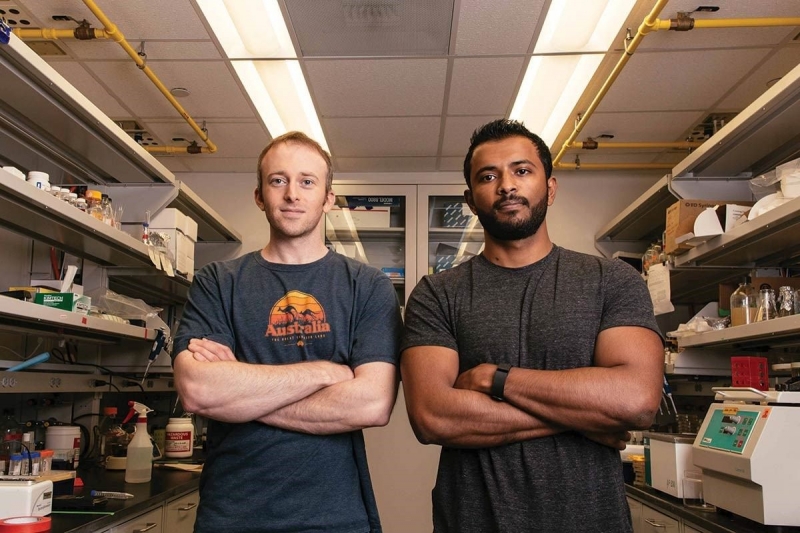In 2020, just as the SARS-CoV-2 coronavirus caused a pandemic of respiratory illness called COVID-19, two chemical engineers and alumni of the University of Houston decided to pivot the product strategy of Luminostics, the company they began forming while in the UH lab of Richard Willson, Huffington-Woestemeyer Professor of chemical and biomolecular engineering and professor of biochemical and biophysical sciences. Based on technology developed in the Willson lab, Luminostics goal is to empower consumers with rapid self-diagnostics.
Talk about timing.
By May 2021, having gotten Emergency Use Authorization from the FDA, Luminostics founders Andrew Paterson and Bala Raja had distributed their Clip COVID Rapid Antigen Test across the United States.
The Clip COVID test, a revolutionary test based on a smartphone-coupled analyzer, uses a nasal swab, a smart phone, and glow-in-the-dark nanoparticles to detect SARS-CoV-2 infection within 30 minutes. In the phone, an image processor quantifies the intensity of the luminescence signal. If the signal is strong enough the result is positive, if it's weak the result is negative.
“We live in a world where you can have all your basic necessities delivered to your home through an app, and yet this pandemic has exposed how far behind the diagnostics industry lags compared to consumer technology and the convenience economy," Paterson said.
“The diagnostics industry is saturated with products that cater to big, centralized labs or testing in the doctor's office,” said Paterson. “There are many applications where it does make sense to do testing in a centralized lab, but there are dozens of other applications where there should be home-tests and there are not, because few companies have tried to take on the technical and regulatory challenges with developing home-testing.”
The path to development
It started as a dream – or at least while on the way to dreamland
One night in 2012, when Willson was putting his young daughter to bed, he fixed his gaze on a glow-in-the-dark star on her ceiling. The mind of this scientist/dad wandered to detectable particles for medical testing.
He had long thought the technology of the home pregnancy test was almost mystical.
“The home pregnancy test format is one of the most remarkable technical developments that anybody ever made," Willson said.
After all, he said, you can buy them inexpensively and they allow people – at home, with no medical training – to measure human chorionic gonadotropin (the pregnancy hormone) with high reliability, at parts-per-billion concentrations.
Willson believed that he and his group of doctoral students could go even farther, creating a test with glowing nanoparticles rather than one that just changes color. The glowing phosphor would make the particles even more detectable and the test more accurate.
Perhaps it was fated, or at the very least, in the stars.
The next day Willson handed the star to Paterson, who was working on light-based diagnostics at the time. Though his interest was piqued, Paterson said he could never have predicted then where that exchange would take him.
"I never would have imagined that the glow-in-the-dark star would have kicked off a chain of events that included glow-in-the-dark nanoparticles for diagnostics becoming the main focus of my Ph.D., the creation of Luminostics, and ultimately using the technology to launch a rapid test during a global pandemic,” said Paterson.
The star that sparked thousands of hours of work
Late nights and early mornings - lots of work came next to make the idea of the original star usable in diagnostics. The scientists had to convert big chunks to particles in the hundreds of nanometers size range to be of use in a lateral flow test stick format. They had to make the particles stable in water and then modify the surface of the particles to attach antibodies or other molecules that allow the particles to bind to the target it is trying to detect.
A year later the team ran a successful lateral flow test with the phosphors. For the next few years, while still in the Willson lab working on technology, Paterson and Raja attended a BioVentures class designed for doctoral students in areas related to life sciences and who are interested in starting a company. Paterson described the class as being like a boot camp.
“Every week we'd present a new iteration of our pitch to a panel of seasoned life science executives who would tear the pitch to pieces," said Paterson. "We'd incorporate the feedback, make our pitch better, and present again the following week.” In 2016, the team got accepted into the famous Y Combinator, which provides seed funding for startups (including Airbnb, DoorDash and Stripe), and moved to Silicon Valley.
The sky - and stars - are the limit
Luminostics is rapidly developing a next generation, highly affordable hardware system to reach the mass over-the-counter market at scale.
Willson still has that star he took off his daughter’s ceiling and handed to Paterson, which led to the Luminostics technology. It lives in a frame now and Willson has promised to give it to Paterson and Raja for the lobby of Building Six – when their company is big enough to have six buildings.
That’s a professor, always raising the bar.

